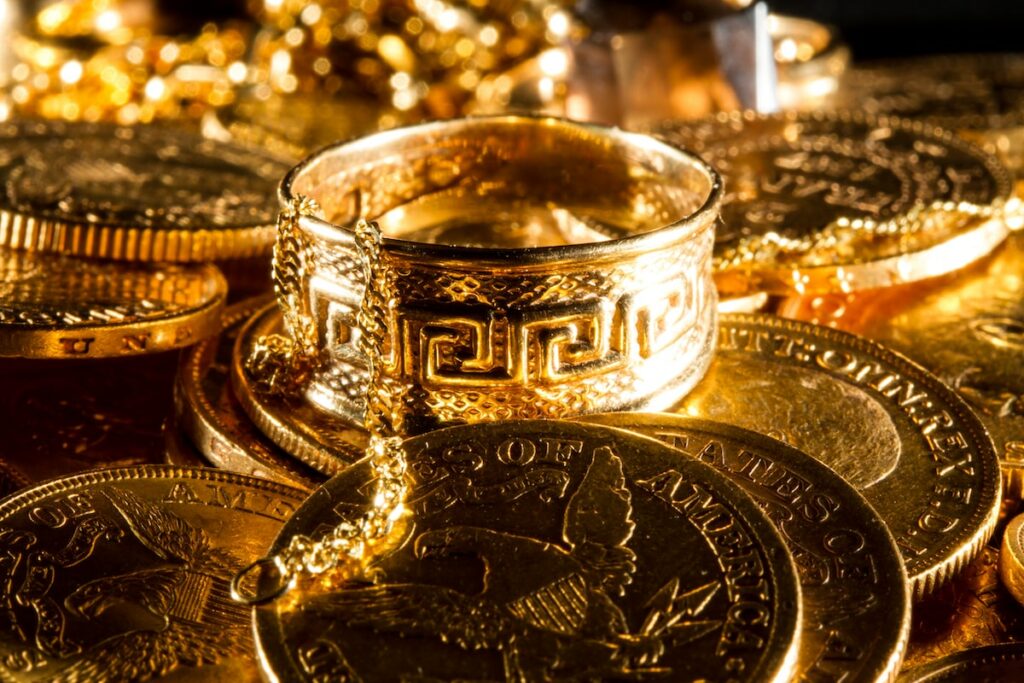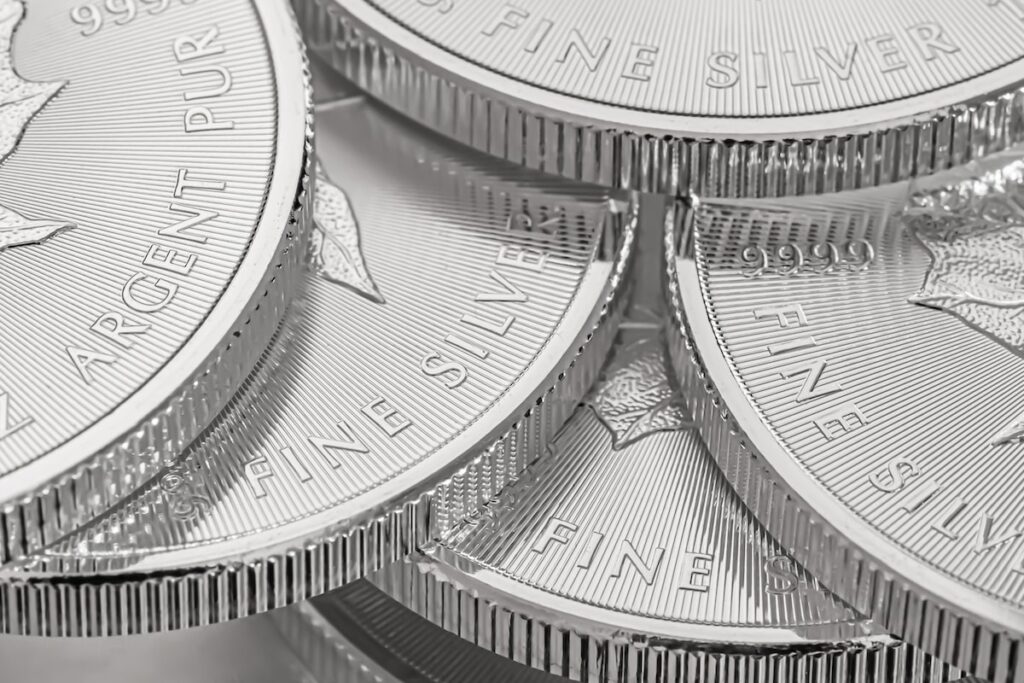Silver stacking has become increasingly popular among those looking to preserve their wealth.
However, with silver stacking comes the challenge of maintaining the shine and color of this precious metal.
Silver can change color and may turn black, brown, green, yellow, gold, or grey. The reaction of silver with moisture or sulfuric gases is the leading cause of its color change. Coins, chains, rings, and jewelry are all subject to tarnishing and appearance changes over time.
This article will answer several questions regarding the color change in silver, including how to prevent silver from tarnishing and changing color.
Why Does Silver Change Colors?
Silver changes in color because of chemical reactions that allow an outer layer to form on the surface of the metal. This layer reflects light differently than the silver beneath it and causes the metal to appear darker or change color altogether.
Silver can change into the following colors:
- Black: The most likely outcome of silver reacting with sulfur is turning black. When silver coins or jewelry are continuously exposed to air, they react with the sulfur compounds in the atmosphere and eventually form a black outer layer of silver sulfide.
- Yellow, Gold, Purple, Grey: Before turning black, some pieces of silver start tarnishing by turning yellow. Further tarnish may result in purplish or grey discoloration.
- Red, Brown: Silver, specifically those that are not pure, may also change into a reddish hue due to a reaction with air, in a process known as oxidation.
- Blue: Silver turning blue is a result of the toning process. A chemical reaction occurs when air, chemicals, heat, and moisture come into contact with silver items. All toned silver eventually turns black.
- Green: A sterling silver item with a bit of copper will most likely turn green when exposed to air for a long time. Copper reacts with moisture in the atmosphere or skin, resulting in green discoloration.
If you frequently touch your silver coins or bars with your bare fingers, the acidity and sweat from your body will eventually tarnish them.
Therefore, it is recommended that you handle these items using gloves or a clean cloth whenever possible.
Your silver rings, chains, and jewelry will also change color when you use household cleaners to polish them. See how silver changes color due to several factors in the above YouTube video.
How Do You Avoid Silver Changing Colors?
To avoid silver changing colors, ensure minimal contact with air, moisture, and various chemicals. Silver should also be stored away from direct sunlight, as UV rays can cause discoloration. Periodically clean your silver pieces with a silver polishing cloth and wear gloves before touching them.
Follow these tips to prevent your silver from changing color:
- Store your silver items with products that absorb moisture. The silica gel sachets that come with new clothing or shoes are ideal for this purpose. Alternatively, you can put a few pieces of chalk in your jewelry box.
- Keep your silver in cool, dry places and out of moisture and sunlight. Avoid storing your silver items in the bathroom or shower areas. Make sure your silver doesn’t come into contact with wood, cardboard, or printed paper. These materials may contain sulfur which can react with silver, changing its color.
- Avoid mixing different types of silver when storing them. Consider using jewelry organizers or different drawer compartments to keep your items separate.
- Store your silver items in proper containers. Silver chains, coins, and jewelry must be placed in airtight containers, uniquely designed silver cloth bags, or jewelry pouches lined with anti-tarnish cloths. To prevent further tarnishing, you can put anti-tarnish slips or blocks inside these storage items.
- Wear your jewelry last when dressing up. Doing so helps prevent smudging them with perfumes, lotions, makeup, and hairspray. Also, remove your jewelry when cleaning with household products or chlorine.
- Polish your silver items regularly using a silver polishing cloth. You can also use chemical cleaners like Wright’s Silver Cream Polish, but with care because they can be toxic when used incorrectly.
- Use cotton gloves or thin vinyl when touching silver. Doing so helps avoid leaving sweat or moisture on your silver pieces. Alternatively, apply absorbent powder on the skin areas that come into contact with jewelry, or clean using soap and water and dry thoroughly.
- Wear your silver pieces regularly instead of leaving them unworn inside jewelry boxes. Weird as it sounds, the natural oils from your skin can prevent your jewelry from tarnishing.
- Avoid having your silver pieces on in heavily polluted environments. Also, take precautions when handling substances that contain sulfur, such as coal, oil, eggs, onions, shellfish, etc.
How Can You Remove Tarnish Color From Silver?
You can remove tarnish color from silver by cleaning it with vinegar, baking soda, and water.
Mixing three parts of baking soda with one part of water and vinegar will do the trick. You can also purchase silver polish and use it to restore the sparkle of your silver items.
Other products you can use to clean your silver are:
- Olive oil and lemon juice
- Baking soda, salt, aluminum foil, and boiling water
- Soap and water, but should be ammonia and phosphate free
The most straightforward way to store your wealth is to stack silver.
However, you must ensure that you make an effort to keep your silver from changing color.
As lovely as silver appears in many colors, its value will decrease if the color changes.
To prevent silver from changing color, follow proper storage and cleaning instructions carefully and keep it away from moisture.
You can also use a little silver polish to bring back the sparkle.
The good thing is that color change for silver is not permanent and can reverse the process.
Common Questions About Silver Tarnish
Does Pure Silver Discolor? Pure silver is less likely to discolor. However, exposure to air or moisture can still cause a formation of a silver sulfide layer. The degree of tarnish will depend on the concentration of the sulfur-containing gases in the atmosphere.
Can I Leave Silver in Vinegar Overnight? It’s recommended to soak your silver in vinegar for 2-3 hours. The best vinegar for cleansing is white vinegar since it lacks a coloring ingredient. Ensure the silver is completely submerged in the white vinegar, then rinse and dry.
Clean the silver items for about 15 minutes if they are not entirely tarnished. You can still add baking soda for deeper cleaning.
Does WD 40 Clean Silver? You can use WD-40 to clean silver. Spray it on your silver pieces and polish them with a soft microfiber cloth. The spray is easy to use and cheap, especially if you can’t afford professional cleaning of your silver.
The composition of the chemicals in WD-40 will not harm the silver items. Instead, it leaves a shiny new look.
Check out the other guides on our site for more:



